Applying Motivational Theories: Maslow & McClelland at ASDA Workplace
VerifiedAdded on 2023/06/08
|5
|1812
|66
Essay
AI Summary
This essay explores the application of motivational theories, specifically Maslow's hierarchy of needs and McClelland's three needs theory, within the context of ASDA, a UK-based retail company. It details how ASDA addresses each level of Maslow's hierarchy, from physiological and safety needs through providing salaries, health insurance, and safe working conditions, to social and esteem needs by fostering teamwork and offering promotions. The essay also examines how ASDA caters to McClelland's needs for achievement, affiliation, and power by providing opportunities for project handling, team collaboration, and career advancement. The analysis concludes that motivational theories are crucial for boosting employee performance and achieving organizational goals, highlighting the importance of understanding and implementing these strategies in the modern workplace.
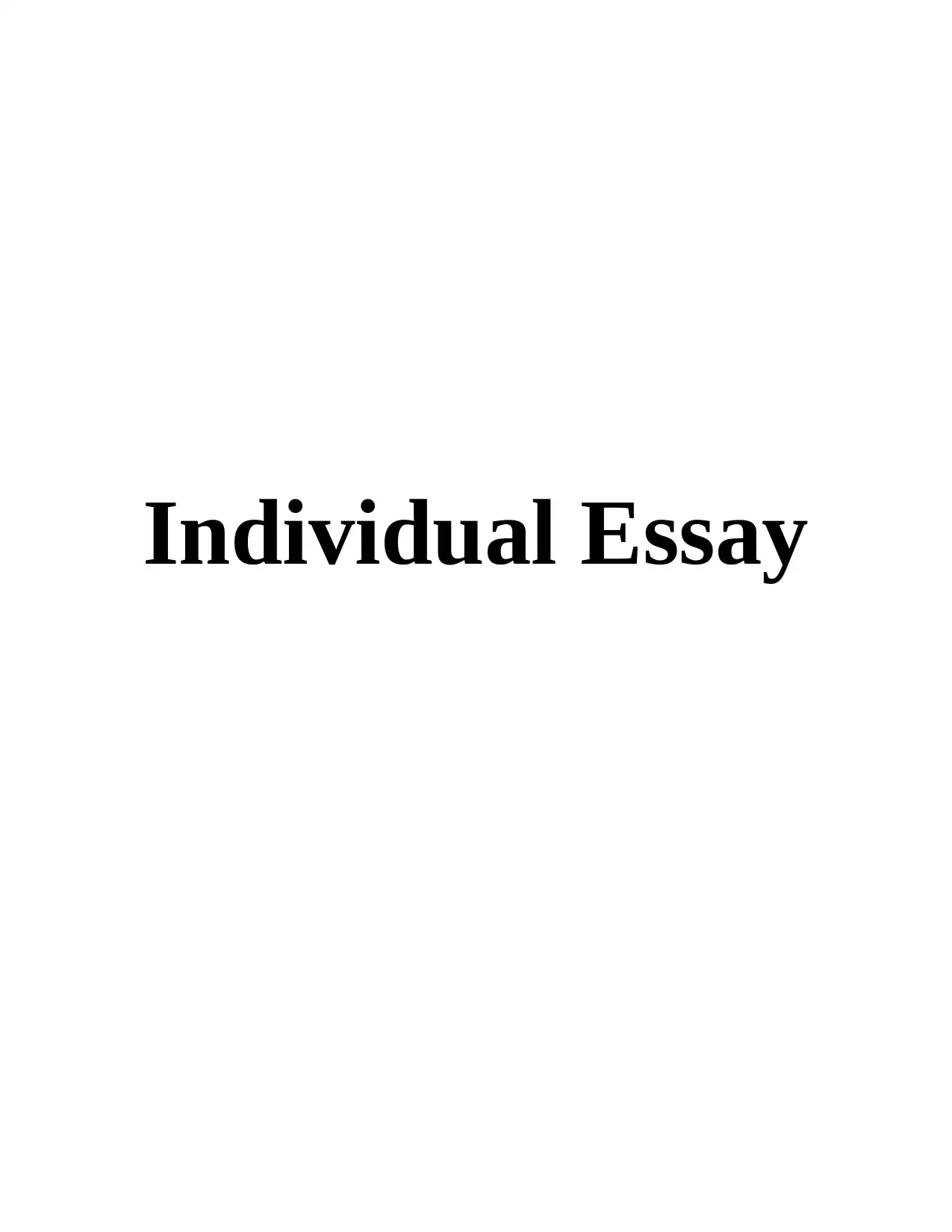
Individual Essay
Paraphrase This Document
Need a fresh take? Get an instant paraphrase of this document with our AI Paraphraser
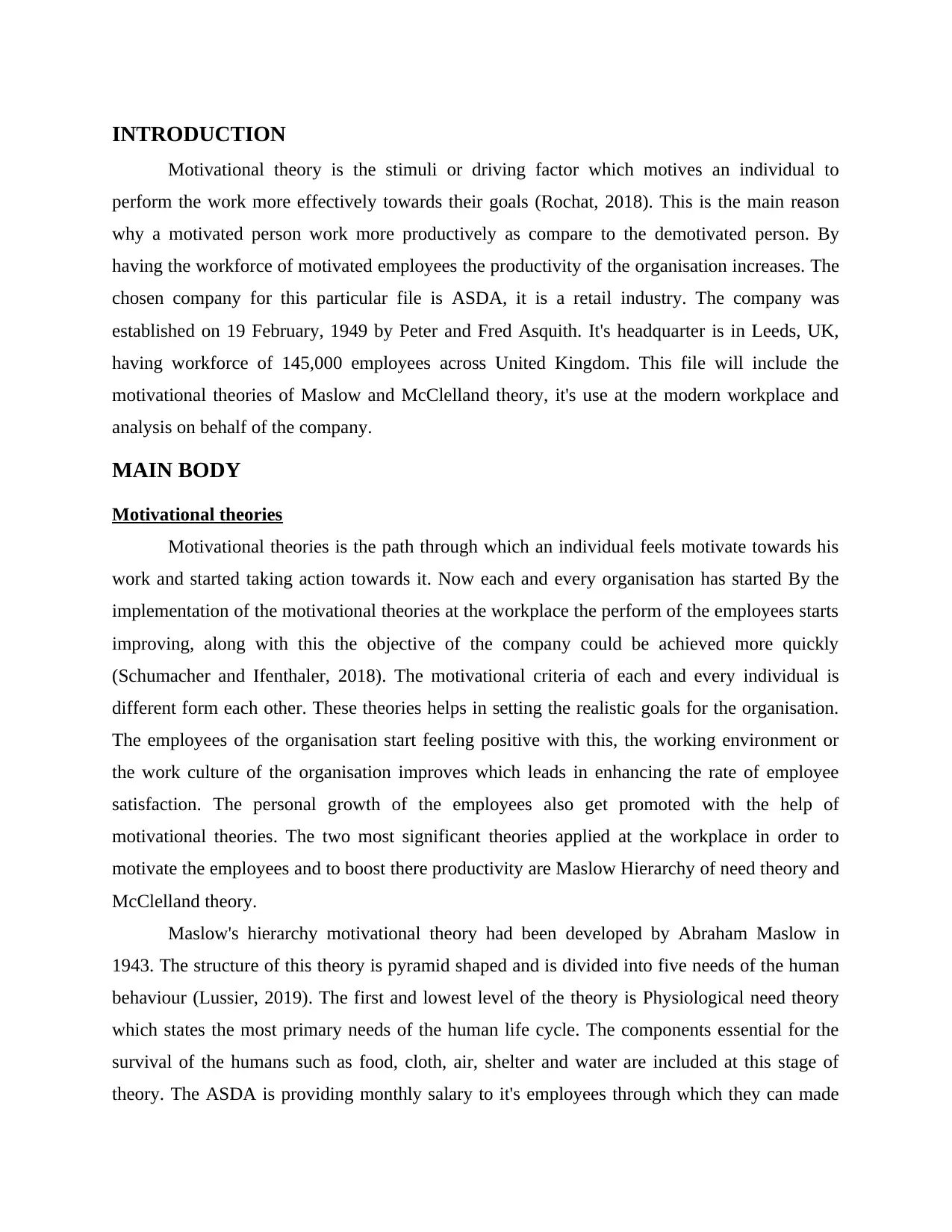
INTRODUCTION
Motivational theory is the stimuli or driving factor which motives an individual to
perform the work more effectively towards their goals (Rochat, 2018). This is the main reason
why a motivated person work more productively as compare to the demotivated person. By
having the workforce of motivated employees the productivity of the organisation increases. The
chosen company for this particular file is ASDA, it is a retail industry. The company was
established on 19 February, 1949 by Peter and Fred Asquith. It's headquarter is in Leeds, UK,
having workforce of 145,000 employees across United Kingdom. This file will include the
motivational theories of Maslow and McClelland theory, it's use at the modern workplace and
analysis on behalf of the company.
MAIN BODY
Motivational theories
Motivational theories is the path through which an individual feels motivate towards his
work and started taking action towards it. Now each and every organisation has started By the
implementation of the motivational theories at the workplace the perform of the employees starts
improving, along with this the objective of the company could be achieved more quickly
(Schumacher and Ifenthaler, 2018). The motivational criteria of each and every individual is
different form each other. These theories helps in setting the realistic goals for the organisation.
The employees of the organisation start feeling positive with this, the working environment or
the work culture of the organisation improves which leads in enhancing the rate of employee
satisfaction. The personal growth of the employees also get promoted with the help of
motivational theories. The two most significant theories applied at the workplace in order to
motivate the employees and to boost there productivity are Maslow Hierarchy of need theory and
McClelland theory.
Maslow's hierarchy motivational theory had been developed by Abraham Maslow in
1943. The structure of this theory is pyramid shaped and is divided into five needs of the human
behaviour (Lussier, 2019). The first and lowest level of the theory is Physiological need theory
which states the most primary needs of the human life cycle. The components essential for the
survival of the humans such as food, cloth, air, shelter and water are included at this stage of
theory. The ASDA is providing monthly salary to it's employees through which they can made
Motivational theory is the stimuli or driving factor which motives an individual to
perform the work more effectively towards their goals (Rochat, 2018). This is the main reason
why a motivated person work more productively as compare to the demotivated person. By
having the workforce of motivated employees the productivity of the organisation increases. The
chosen company for this particular file is ASDA, it is a retail industry. The company was
established on 19 February, 1949 by Peter and Fred Asquith. It's headquarter is in Leeds, UK,
having workforce of 145,000 employees across United Kingdom. This file will include the
motivational theories of Maslow and McClelland theory, it's use at the modern workplace and
analysis on behalf of the company.
MAIN BODY
Motivational theories
Motivational theories is the path through which an individual feels motivate towards his
work and started taking action towards it. Now each and every organisation has started By the
implementation of the motivational theories at the workplace the perform of the employees starts
improving, along with this the objective of the company could be achieved more quickly
(Schumacher and Ifenthaler, 2018). The motivational criteria of each and every individual is
different form each other. These theories helps in setting the realistic goals for the organisation.
The employees of the organisation start feeling positive with this, the working environment or
the work culture of the organisation improves which leads in enhancing the rate of employee
satisfaction. The personal growth of the employees also get promoted with the help of
motivational theories. The two most significant theories applied at the workplace in order to
motivate the employees and to boost there productivity are Maslow Hierarchy of need theory and
McClelland theory.
Maslow's hierarchy motivational theory had been developed by Abraham Maslow in
1943. The structure of this theory is pyramid shaped and is divided into five needs of the human
behaviour (Lussier, 2019). The first and lowest level of the theory is Physiological need theory
which states the most primary needs of the human life cycle. The components essential for the
survival of the humans such as food, cloth, air, shelter and water are included at this stage of
theory. The ASDA is providing monthly salary to it's employees through which they can made
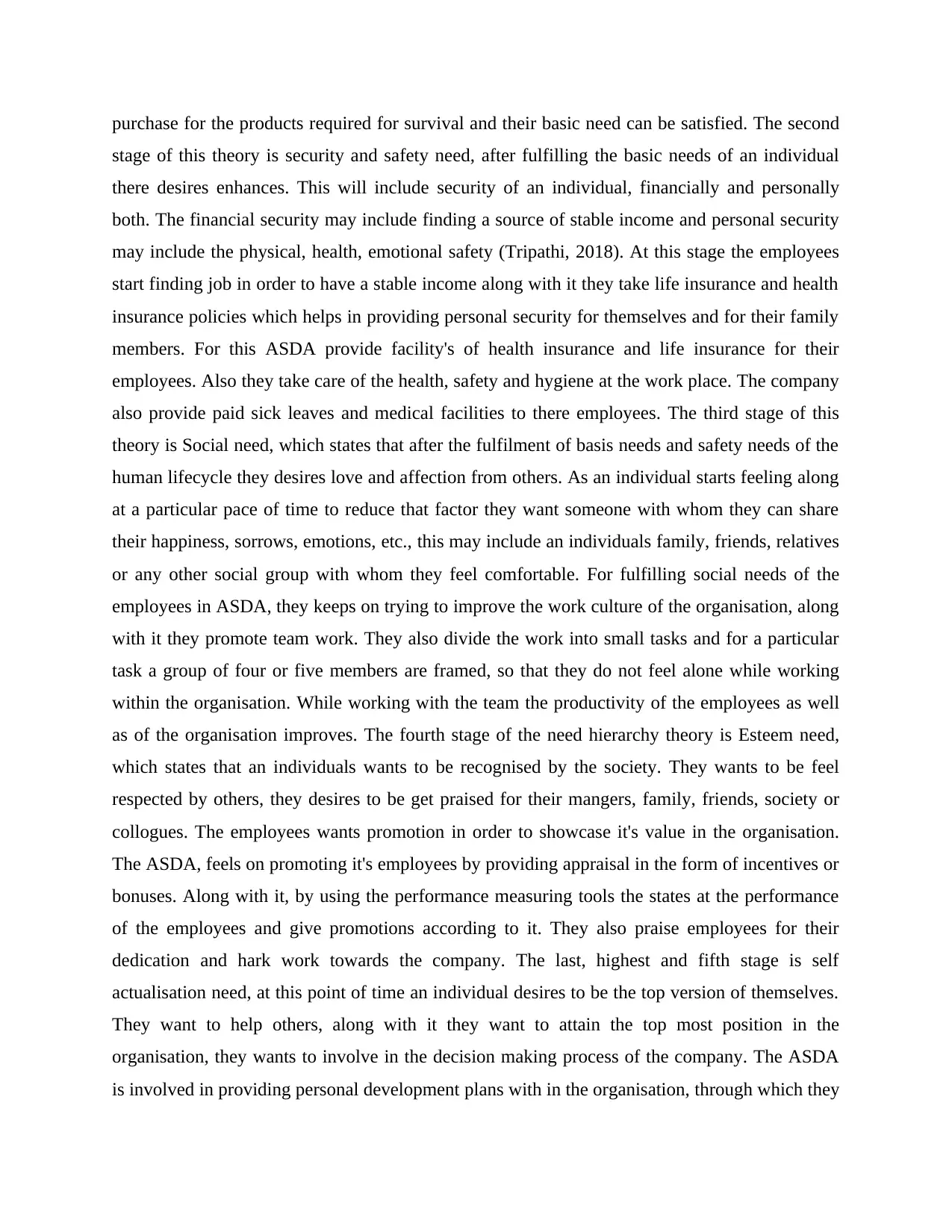
purchase for the products required for survival and their basic need can be satisfied. The second
stage of this theory is security and safety need, after fulfilling the basic needs of an individual
there desires enhances. This will include security of an individual, financially and personally
both. The financial security may include finding a source of stable income and personal security
may include the physical, health, emotional safety (Tripathi, 2018). At this stage the employees
start finding job in order to have a stable income along with it they take life insurance and health
insurance policies which helps in providing personal security for themselves and for their family
members. For this ASDA provide facility's of health insurance and life insurance for their
employees. Also they take care of the health, safety and hygiene at the work place. The company
also provide paid sick leaves and medical facilities to there employees. The third stage of this
theory is Social need, which states that after the fulfilment of basis needs and safety needs of the
human lifecycle they desires love and affection from others. As an individual starts feeling along
at a particular pace of time to reduce that factor they want someone with whom they can share
their happiness, sorrows, emotions, etc., this may include an individuals family, friends, relatives
or any other social group with whom they feel comfortable. For fulfilling social needs of the
employees in ASDA, they keeps on trying to improve the work culture of the organisation, along
with it they promote team work. They also divide the work into small tasks and for a particular
task a group of four or five members are framed, so that they do not feel alone while working
within the organisation. While working with the team the productivity of the employees as well
as of the organisation improves. The fourth stage of the need hierarchy theory is Esteem need,
which states that an individuals wants to be recognised by the society. They wants to be feel
respected by others, they desires to be get praised for their mangers, family, friends, society or
collogues. The employees wants promotion in order to showcase it's value in the organisation.
The ASDA, feels on promoting it's employees by providing appraisal in the form of incentives or
bonuses. Along with it, by using the performance measuring tools the states at the performance
of the employees and give promotions according to it. They also praise employees for their
dedication and hark work towards the company. The last, highest and fifth stage is self
actualisation need, at this point of time an individual desires to be the top version of themselves.
They want to help others, along with it they want to attain the top most position in the
organisation, they wants to involve in the decision making process of the company. The ASDA
is involved in providing personal development plans with in the organisation, through which they
stage of this theory is security and safety need, after fulfilling the basic needs of an individual
there desires enhances. This will include security of an individual, financially and personally
both. The financial security may include finding a source of stable income and personal security
may include the physical, health, emotional safety (Tripathi, 2018). At this stage the employees
start finding job in order to have a stable income along with it they take life insurance and health
insurance policies which helps in providing personal security for themselves and for their family
members. For this ASDA provide facility's of health insurance and life insurance for their
employees. Also they take care of the health, safety and hygiene at the work place. The company
also provide paid sick leaves and medical facilities to there employees. The third stage of this
theory is Social need, which states that after the fulfilment of basis needs and safety needs of the
human lifecycle they desires love and affection from others. As an individual starts feeling along
at a particular pace of time to reduce that factor they want someone with whom they can share
their happiness, sorrows, emotions, etc., this may include an individuals family, friends, relatives
or any other social group with whom they feel comfortable. For fulfilling social needs of the
employees in ASDA, they keeps on trying to improve the work culture of the organisation, along
with it they promote team work. They also divide the work into small tasks and for a particular
task a group of four or five members are framed, so that they do not feel alone while working
within the organisation. While working with the team the productivity of the employees as well
as of the organisation improves. The fourth stage of the need hierarchy theory is Esteem need,
which states that an individuals wants to be recognised by the society. They wants to be feel
respected by others, they desires to be get praised for their mangers, family, friends, society or
collogues. The employees wants promotion in order to showcase it's value in the organisation.
The ASDA, feels on promoting it's employees by providing appraisal in the form of incentives or
bonuses. Along with it, by using the performance measuring tools the states at the performance
of the employees and give promotions according to it. They also praise employees for their
dedication and hark work towards the company. The last, highest and fifth stage is self
actualisation need, at this point of time an individual desires to be the top version of themselves.
They want to help others, along with it they want to attain the top most position in the
organisation, they wants to involve in the decision making process of the company. The ASDA
is involved in providing personal development plans with in the organisation, through which they
⊘ This is a preview!⊘
Do you want full access?
Subscribe today to unlock all pages.

Trusted by 1+ million students worldwide
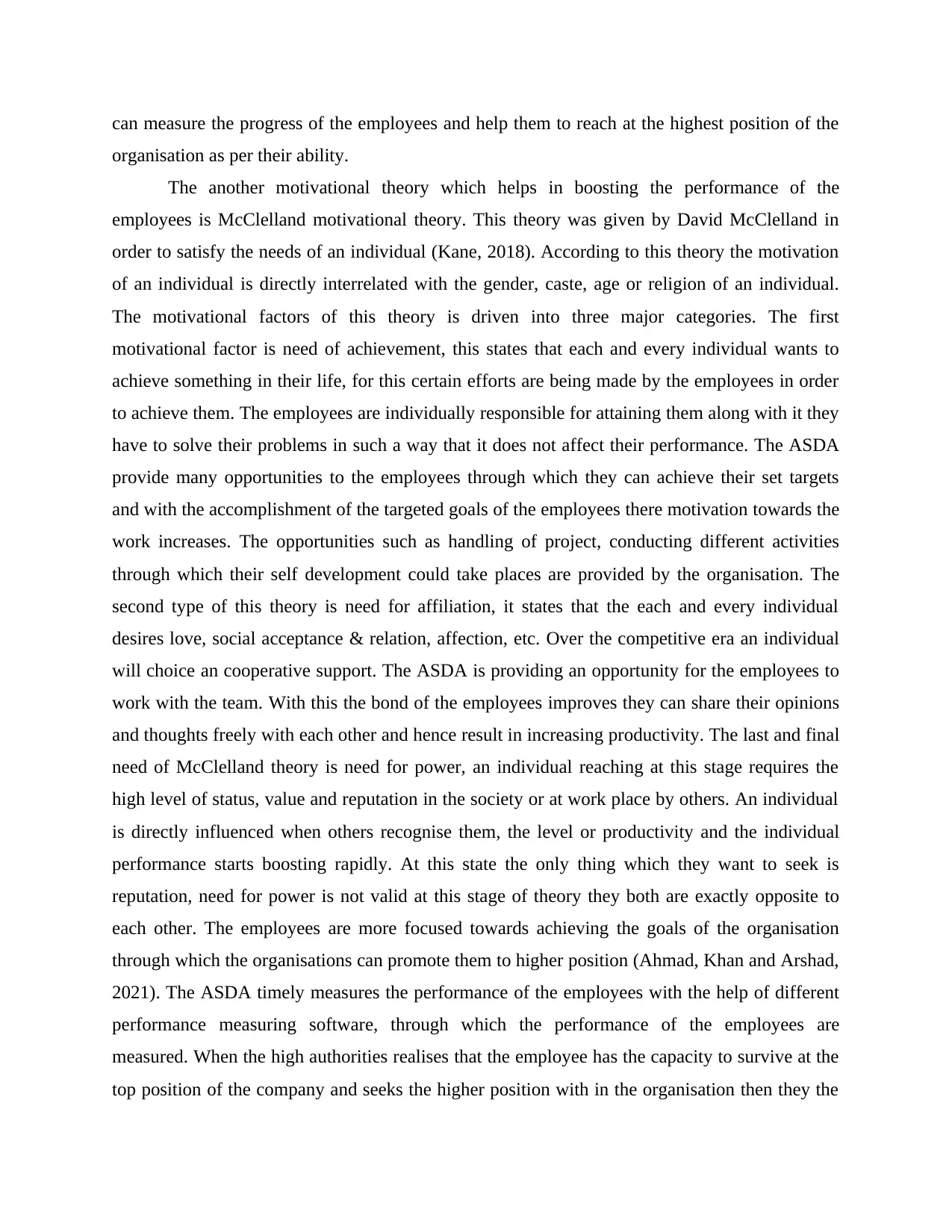
can measure the progress of the employees and help them to reach at the highest position of the
organisation as per their ability.
The another motivational theory which helps in boosting the performance of the
employees is McClelland motivational theory. This theory was given by David McClelland in
order to satisfy the needs of an individual (Kane, 2018). According to this theory the motivation
of an individual is directly interrelated with the gender, caste, age or religion of an individual.
The motivational factors of this theory is driven into three major categories. The first
motivational factor is need of achievement, this states that each and every individual wants to
achieve something in their life, for this certain efforts are being made by the employees in order
to achieve them. The employees are individually responsible for attaining them along with it they
have to solve their problems in such a way that it does not affect their performance. The ASDA
provide many opportunities to the employees through which they can achieve their set targets
and with the accomplishment of the targeted goals of the employees there motivation towards the
work increases. The opportunities such as handling of project, conducting different activities
through which their self development could take places are provided by the organisation. The
second type of this theory is need for affiliation, it states that the each and every individual
desires love, social acceptance & relation, affection, etc. Over the competitive era an individual
will choice an cooperative support. The ASDA is providing an opportunity for the employees to
work with the team. With this the bond of the employees improves they can share their opinions
and thoughts freely with each other and hence result in increasing productivity. The last and final
need of McClelland theory is need for power, an individual reaching at this stage requires the
high level of status, value and reputation in the society or at work place by others. An individual
is directly influenced when others recognise them, the level or productivity and the individual
performance starts boosting rapidly. At this state the only thing which they want to seek is
reputation, need for power is not valid at this stage of theory they both are exactly opposite to
each other. The employees are more focused towards achieving the goals of the organisation
through which the organisations can promote them to higher position (Ahmad, Khan and Arshad,
2021). The ASDA timely measures the performance of the employees with the help of different
performance measuring software, through which the performance of the employees are
measured. When the high authorities realises that the employee has the capacity to survive at the
top position of the company and seeks the higher position with in the organisation then they the
organisation as per their ability.
The another motivational theory which helps in boosting the performance of the
employees is McClelland motivational theory. This theory was given by David McClelland in
order to satisfy the needs of an individual (Kane, 2018). According to this theory the motivation
of an individual is directly interrelated with the gender, caste, age or religion of an individual.
The motivational factors of this theory is driven into three major categories. The first
motivational factor is need of achievement, this states that each and every individual wants to
achieve something in their life, for this certain efforts are being made by the employees in order
to achieve them. The employees are individually responsible for attaining them along with it they
have to solve their problems in such a way that it does not affect their performance. The ASDA
provide many opportunities to the employees through which they can achieve their set targets
and with the accomplishment of the targeted goals of the employees there motivation towards the
work increases. The opportunities such as handling of project, conducting different activities
through which their self development could take places are provided by the organisation. The
second type of this theory is need for affiliation, it states that the each and every individual
desires love, social acceptance & relation, affection, etc. Over the competitive era an individual
will choice an cooperative support. The ASDA is providing an opportunity for the employees to
work with the team. With this the bond of the employees improves they can share their opinions
and thoughts freely with each other and hence result in increasing productivity. The last and final
need of McClelland theory is need for power, an individual reaching at this stage requires the
high level of status, value and reputation in the society or at work place by others. An individual
is directly influenced when others recognise them, the level or productivity and the individual
performance starts boosting rapidly. At this state the only thing which they want to seek is
reputation, need for power is not valid at this stage of theory they both are exactly opposite to
each other. The employees are more focused towards achieving the goals of the organisation
through which the organisations can promote them to higher position (Ahmad, Khan and Arshad,
2021). The ASDA timely measures the performance of the employees with the help of different
performance measuring software, through which the performance of the employees are
measured. When the high authorities realises that the employee has the capacity to survive at the
top position of the company and seeks the higher position with in the organisation then they the
Paraphrase This Document
Need a fresh take? Get an instant paraphrase of this document with our AI Paraphraser
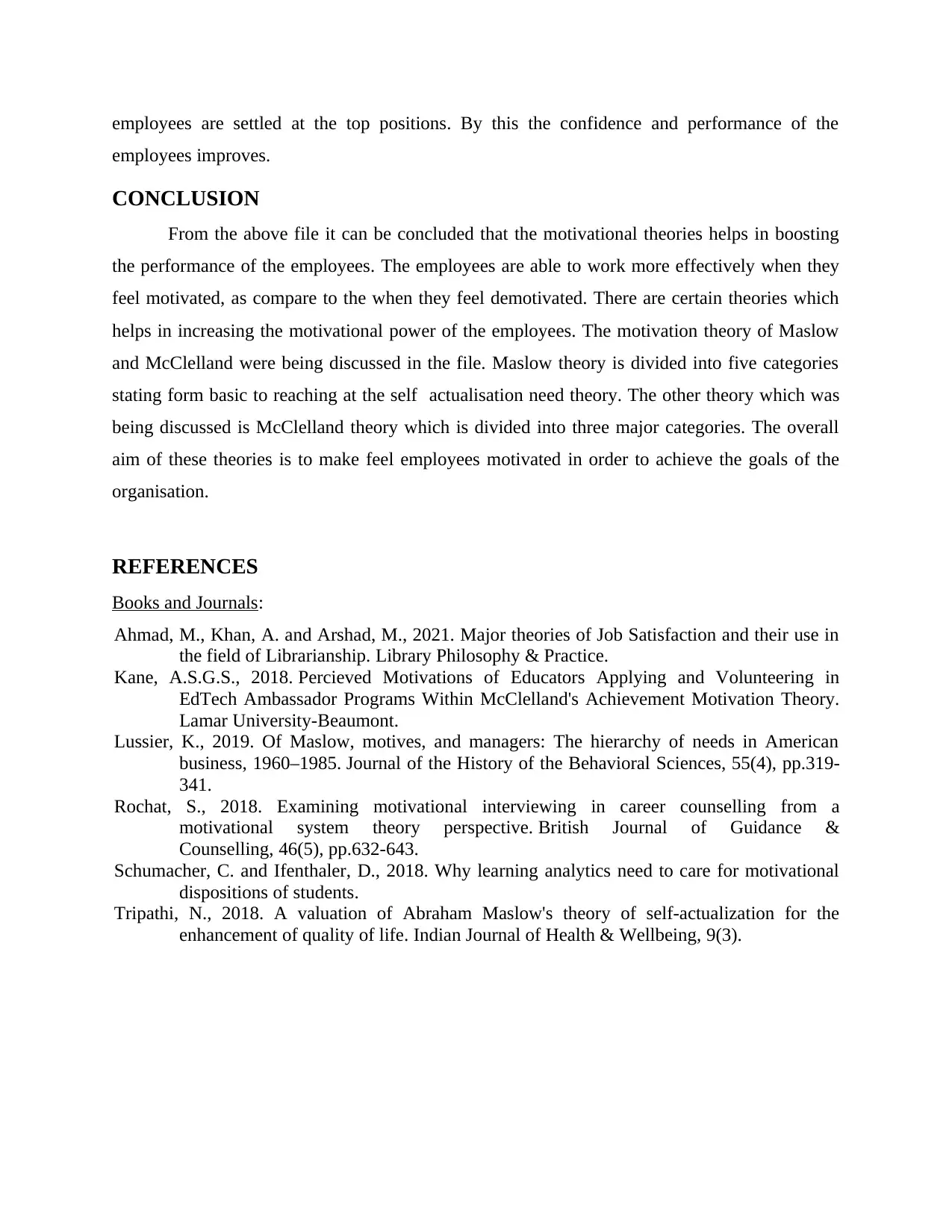
employees are settled at the top positions. By this the confidence and performance of the
employees improves.
CONCLUSION
From the above file it can be concluded that the motivational theories helps in boosting
the performance of the employees. The employees are able to work more effectively when they
feel motivated, as compare to the when they feel demotivated. There are certain theories which
helps in increasing the motivational power of the employees. The motivation theory of Maslow
and McClelland were being discussed in the file. Maslow theory is divided into five categories
stating form basic to reaching at the self actualisation need theory. The other theory which was
being discussed is McClelland theory which is divided into three major categories. The overall
aim of these theories is to make feel employees motivated in order to achieve the goals of the
organisation.
REFERENCES
Books and Journals:
Ahmad, M., Khan, A. and Arshad, M., 2021. Major theories of Job Satisfaction and their use in
the field of Librarianship. Library Philosophy & Practice.
Kane, A.S.G.S., 2018. Percieved Motivations of Educators Applying and Volunteering in
EdTech Ambassador Programs Within McClelland's Achievement Motivation Theory.
Lamar University-Beaumont.
Lussier, K., 2019. Of Maslow, motives, and managers: The hierarchy of needs in American
business, 1960–1985. Journal of the History of the Behavioral Sciences, 55(4), pp.319-
341.
Rochat, S., 2018. Examining motivational interviewing in career counselling from a
motivational system theory perspective. British Journal of Guidance &
Counselling, 46(5), pp.632-643.
Schumacher, C. and Ifenthaler, D., 2018. Why learning analytics need to care for motivational
dispositions of students.
Tripathi, N., 2018. A valuation of Abraham Maslow's theory of self-actualization for the
enhancement of quality of life. Indian Journal of Health & Wellbeing, 9(3).
employees improves.
CONCLUSION
From the above file it can be concluded that the motivational theories helps in boosting
the performance of the employees. The employees are able to work more effectively when they
feel motivated, as compare to the when they feel demotivated. There are certain theories which
helps in increasing the motivational power of the employees. The motivation theory of Maslow
and McClelland were being discussed in the file. Maslow theory is divided into five categories
stating form basic to reaching at the self actualisation need theory. The other theory which was
being discussed is McClelland theory which is divided into three major categories. The overall
aim of these theories is to make feel employees motivated in order to achieve the goals of the
organisation.
REFERENCES
Books and Journals:
Ahmad, M., Khan, A. and Arshad, M., 2021. Major theories of Job Satisfaction and their use in
the field of Librarianship. Library Philosophy & Practice.
Kane, A.S.G.S., 2018. Percieved Motivations of Educators Applying and Volunteering in
EdTech Ambassador Programs Within McClelland's Achievement Motivation Theory.
Lamar University-Beaumont.
Lussier, K., 2019. Of Maslow, motives, and managers: The hierarchy of needs in American
business, 1960–1985. Journal of the History of the Behavioral Sciences, 55(4), pp.319-
341.
Rochat, S., 2018. Examining motivational interviewing in career counselling from a
motivational system theory perspective. British Journal of Guidance &
Counselling, 46(5), pp.632-643.
Schumacher, C. and Ifenthaler, D., 2018. Why learning analytics need to care for motivational
dispositions of students.
Tripathi, N., 2018. A valuation of Abraham Maslow's theory of self-actualization for the
enhancement of quality of life. Indian Journal of Health & Wellbeing, 9(3).
1 out of 5
Related Documents
Your All-in-One AI-Powered Toolkit for Academic Success.
+13062052269
info@desklib.com
Available 24*7 on WhatsApp / Email
![[object Object]](/_next/static/media/star-bottom.7253800d.svg)
Unlock your academic potential
Copyright © 2020–2025 A2Z Services. All Rights Reserved. Developed and managed by ZUCOL.




